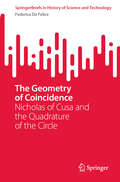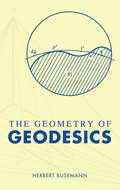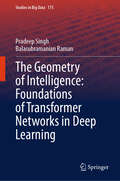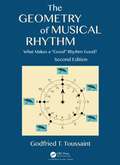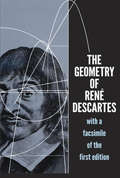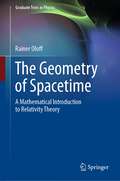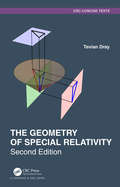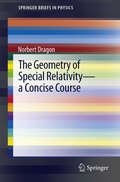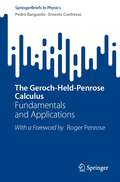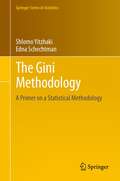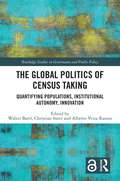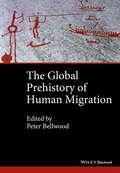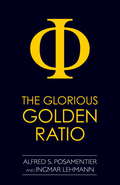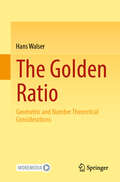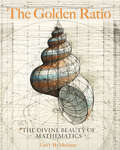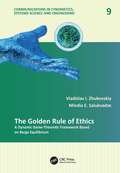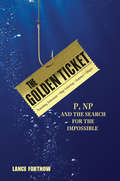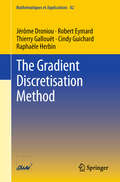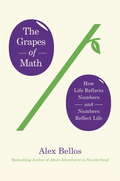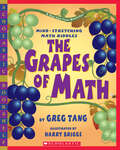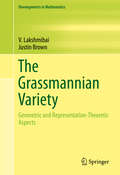- Table View
- List View
The Geometry of Coincidence: Nicholas of Cusa and the Quadrature of the Circle (SpringerBriefs in History of Science and Technology)
by Federica De FeliceThis book offers a contribution to our understanding of Nicholas of Cusa&’s theory of geometry. It is based not only on his—generally more famous—philosophical texts (e.g., De docta ignorantia, Idiota, etc.), but also, and more significantly, on the strictly speaking mathematical texts drafted between 1445 and 1459, where Cusanus attempts to provide a solution to the vexata quaestio of the squaring of the circle. First critically edited in 2010—and translated into Italian by the author in 2020—Cusanus&’ Scripta mathematica are here scrutinized as to their context, genesis, and content, in order to shed light, on the one hand, on the philosophical and theological motives behind Cusanus&’ mathematical endeavours; and, on the other hand, on the scope and limits of Cusanus&’ geometrical constructive attempts to reach &“mathematical perfection&”. In addition to providing a scrupulous survey of Cusanus&’ sources on mathematics, this book focuses on a little explored aspect in Cusanus&’ work, namely his original theory of geometrical space as men&’s space, where the activity of mensurare takes place, establishing relations of continuous proportionality to the original unity. In conclusion, the author provides an extensive account on the reception of Cusanus&’ mathematical texts, from their early dissemination to the reactions of several thinkers throughout history, ensuring a full and rounded overview of Cusanus&’ work in geometry, mathematics, and philosophy.
The Geometry of Geodesics
by Herbert BusemannA comprehensive approach to qualitative problems in intrinsic differential geometry, this text for upper-level undergraduates and graduate students emphasizes cases in which geodesics possess only local uniqueness properties--and consequently, the relations to the foundations of geometry are decidedly less relevant, and Finsler spaces become the principal subject.This direct approach has produced many new results and has materially generalized many known phenomena. Author Herbert Busemann begins with an explanation of the basic concepts, including compact metric spaces, convergence of point sets, motion and isometry, segments, and geodesics. Subsequent topics include Desarguesian spaces, with discussions of Riemann and Finsler spaces and Beltrami's theorem; perpendiculars and parallels, with examinations of higher-dimensional Minkowskian geometry and the Minkowski plane; and covering spaces, including locally isometric space, the universal covering space, fundamental sets, free homotopy and closed geodesics, and transitive geodesics on surfaces of higher genus. Concluding chapters explore the influence of the sign of the curvature on the geodesics, and homogenous spaces, including those with flat bisectors.
The Geometry of Intelligence: Foundations of Transformer Networks in Deep Learning (Studies in Big Data #175)
by Balasubramanian Raman Pradeep SinghThis book offers an in-depth exploration of the mathematical foundations underlying transformer networks, the cornerstone of modern AI across various domains. Unlike existing literature that focuses primarily on implementation, this work delves into the elegant geometry, symmetry, and mathematical structures that drive the success of transformers. Through rigorous analysis and theoretical insights, the book unravels the complex relationships and dependencies that these models capture, providing a comprehensive understanding of their capabilities. Designed for researchers, academics, and advanced practitioners, this text bridges the gap between practical application and theoretical exploration. Readers will gain a profound understanding of how transformers operate in abstract spaces, equipping them with the knowledge to innovate, optimize, and push the boundaries of AI. Whether you seek to deepen your expertise or pioneer the next generation of AI models, this book is an essential resource on the mathematical principles of transformers.
The Geometry of Musical Rhythm: What Makes a "Good" Rhythm Good?, Second Edition
by Godfried T. ToussaintThe original edition of The Geometry of Musical Rhythm was the first book to provide a systematic and accessible computational geometric analysis of the musical rhythms of the world. It explained how the study of the mathematical properties of musical rhythm generates common mathematical problems that arise in a variety of seemingly disparate fields. The book also introduced the distance approach to phylogenetic analysis and illustrated its application to the study of musical rhythm. The new edition retains all of this, while also adding 100 pages, 93 figures, 225 new references, and six new chapters covering topics such as meter and metric complexity, rhythmic grouping, expressive timbre and timing in rhythmic performance, and evolution phylogenetic analysis of ancient Greek paeonic rhythms. In addition, further context is provided to give the reader a fuller and richer insight into the historical connections between music and mathematics.
The Geometry of Physics
by Theodore FrankelThis book provides a working knowledge of those parts of exterior differential forms, differential geometry, algebraic and differential topology, Lie groups, vector bundles and Chern forms that are essential for a deeper understanding of both classical and modern physics and engineering. Included are discussions of analytical and fluid dynamics, electromagnetism (in flat and curved space), thermodynamics, the Dirac operator and spinors, and gauge fields, including Yang–Mills, the Aharonov–Bohm effect, Berry phase and instanton winding numbers, quarks and quark model for mesons. Before discussing abstract notions of differential geometry, geometric intuition is developed through a rather extensive introduction to the study of surfaces in ordinary space. The book is ideal for graduate and advanced undergraduate students of physics, engineering or mathematics as a course text or for self study. This third edition includes an overview of Cartan's exterior differential forms, which previews many of the geometric concepts developed in the text.
The Geometry of René Descartes: with a Facsimile of the First Edition
by René DescartesThis is an unabridged republication of the definitive English translation of one of the very greatest classics of science. Originally published in 1637, it has been characterized as "the greatest single step ever made in the progress of the exact sciences" (John Stuart Mill); as a book which "remade geometry and made modern geometry possible" (Eric Temple Bell). It "revolutionized the entire conception of the object of mathematical science" (J. Hadamard).With this volume Descartes founded modern analytical geometry. Reducing geometry to algebra and analysis and, conversely, showing that analysis may be translated into geometry, it opened the way for modern mathematics. Descartes was the first to classify curves systematically and to demonstrate algebraic solution of geometric curves. His geometric interpretation of negative quantities led to later concepts of continuity and the theory of function. The third book contains important contributions to the theory of equations.This edition contains the entire definitive Smith-Latham translation of Descartes' three books: Problems the Construction of which Requires Only Straight Lines and Circles; On the Nature of Curved Lines; and On the Construction of Solid and Supersolid Problems. Interleaved page by page with the translation is a complete facsimile of the 1637 French text, together with all Descartes' original illustrations; 248 footnotes explain the text and add further bibliography.
The Geometry of Spacetime: A Mathematical Introduction to Relativity Theory (Graduate Texts in Physics)
by Rainer OloffThis book systematically develops the mathematical foundations of the theory of relativity and links them to physical relations. For this purpose, differential geometry on manifolds is introduced first, including differentiation and integration, and special relativity is presented as tensor calculus on tangential spaces. Using Einstein's field equations relating curvature to matter, the relativistic effects in the solar system including black holes are discussed in detail. The text is aimed at students of physics and mathematics and assumes only basic knowledge of classical differential and integral calculus and linear algebra.
The Geometry of Special Relativity (Textbooks in Mathematics)
by Tevian DrayThis unique book presents a particularly beautiful way of looking at special relativity. The author encourages students to see beyond the formulas to the deeper structure.The unification of space and time introduced by Einstein’s special theory of relativity is one of the cornerstones of the modern scientific description of the universe. Yet the unification is counterintuitive because we perceive time very differently from space. Even in relativity, time is not just another dimension, it is one with different propertiesThe book treats the geometry of hyperbolas as the key to understanding special relativity. The author simplifies the formulas and emphasizes their geometric content. Many important relations, including the famous relativistic addition formula for velocities, then follow directly from the appropriate (hyperbolic) trigonometric addition formulas.Prior mastery of (ordinary) trigonometry is sufficient for most of the material presented, although occasional use is made of elementary differential calculus, and the chapter on electromagnetism assumes some more advanced knowledge.Changes to the Second Edition The treatment of Minkowski space and spacetime diagrams has been expanded. Several new topics have been added, including a geometric derivation of Lorentz transformations, a discussion of three-dimensional spacetime diagrams, and a brief geometric description of "area" and how it can be used to measure time and distance. Minor notational changes were made to avoid conflict with existing usagein the literature. Table of Contents Preface1. Introduction.2. The Physics of Special Relativity.3. Circle Geometry.4. Hyperbola Geometry. 5. The Geometry of Special Relativity. 6. Applications.7. Problems III.8. Paradoxes.9. Relativistic Mechanics.10. Problems II.11. Relativistic Electromagnetism. 12. Problems III.13. Beyond Special Relativity. 14. Three-Dimensional Spacetime Diagrams.15. Minkowski Area via Light Boxes.16. Hyperbolic Geometry.17. Calculus.Bibliography. Author Biography Tevian Dray is a Professor of Mathematics at Oregon State University. His research lies at the interface between mathematics and physics, involving differential geometry and general relativity, as well as nonassociative algebra and particle physics; he also studies student understanding of "middle-division" mathematics and physics content. Educated at MIT and Berkeley, he held postdoctoral positions in both mathematics and physics in several countries prior to coming to OSU in 1988. Professor Dray is a Fellow of the American Physical Society for his work in relativity, and an award-winning teacher.
The Geometry of Special Relativity - a Concise Course
by Norbert DragonIn this concise primer it is shown that, with simple diagrams, the phenomena of time dilatation, length contraction and Lorentz transformations can be deduced from the fact that in a vacuum one cannot distinguish physically straight and uniform motion from rest, and that the speed of light does not depend on the speed of either the source or the observer. The text proceeds to derive the important results of relativistic physics and to resolve its apparent paradoxes. A short introduction into the covariant formulation of electrodynamics is also given. This publication addresses, in particular, students of physics and mathematics in their final undergraduate year.
The Geroch-Held-Penrose Calculus: Fundamentals and Applications (SpringerBriefs in Physics)
by Pedro Bargueño Ernesto ContrerasThis book offers a primer on the fundamentals and applications of the Geroch-Held-Penrose (GHP) calculus, a powerful formalism designed for spacetimes that occur frequently in the teaching of General Relativity. Specifically, the book shows in detail the power of the calculus when dealing with spherically symmetric spacetimes. After introducing the basics, a new look at all the classical spherically symmetric black hole solutions is given within the GHP formalism. This is then employed to give new insights into the Tolman-Oppenheimer-Volkoff equations for stellar structure, including a derivation of new exact anisotropic fluid solutions. Finally, a re-writing of some essential features of black hole thermodynamics within the GHP formalism is performed. The book is based on the authors' lecture notes, used in their undergraduate and graduate lectures and while supervising their upper undergraduate and graduate students. To fully benefit from this concise primer, readers only need an undergraduate background in general relativity.
The Gini Methodology
by Shlomo Yitzhaki Edna SchechtmanGini's mean difference (GMD) was first introduced by Corrado Gini in 1912 as an alternative measure of variability. GMD and the parameters which are derived from it (such as the Gini coefficient or the concentration ratio) have been in use in the area of income distribution for almost a century. In practice, the use of GMD as a measure of variability is justified whenever the investigator is not ready to impose, without questioning, the convenient world of normality. This makes the GMD of critical importance in the complex research of statisticians, economists, econometricians, and policy makers. This book focuses on imitating analyses that are based on variance by replacing variance with the GMD and its variants. In this way, the text showcases how almost everything that can be done with the variance as a measure of variability, can be replicated by using Gini. Beyond this, there are marked benefits to utilizing Gini as opposed to other methods. One of the advantages of using Gini methodology is that it provides a unified system that enables the user to learn about various aspects of the underlying distribution. It also provides a systematic method and a unified terminology. Using Gini methodology can reduce the risk of imposing assumptions that are not supported by the data on the model. With these benefits in mind the text uses the covariance-based approach, though applications to other approaches are mentioned as well.
The Global Politics of Census Taking: Quantifying Populations, Institutional Autonomy, Innovation (Routledge Studies in Governance and Public Policy)
by Christian Suter Walter Bartl Alberto Veira-RamosThis book examines in detail the state of the art on census taking to spark a more vivid debate on what some may see as a rather technical – and hence uncontroversial – field of inquiry.Against the backdrop of controversy between instrumental and performative theoretical stances towards census taking, it analyses the historical trajectories and political implications of seemingly technical decisions made during the quantification process by focusing on the 2020 round of censuses, which have been particularly revealing as activities have been affected by the ongoing COVID-19 pandemic and the ensuing containment policies. Through case studies of countries from the Global North and the Global South, the book highlights the consequences of, and innovations and challenges in census taking focusing on three particular areas of concern – the politics of the census in terms of identity politics; the institutional autonomy of the census; and significant and transformative methodological innovations.This book will be of key interest to scholars, students and practitioners of quantification studies, and social demography and more broadly to public policy, governance, comparative politics and the broader social sciences.
The Global Prehistory of Human Migration
by Immanuel NessPreviously published as the first volume of The Encyclopedia of Global Human Migration, this work is devoted exclusively to prehistoric migration, covering all periods and places from the first hominin migrations out of Africa through the end of prehistory. Presents interdisciplinary coverage of this topic, including scholarship from the fields of archaeology, anthropology, genetics, biology, linguistics, and more Includes contributions from a diverse international team of authors, representing 17 countries and a variety of disciplines Divided into two sections, covering the Pleistocene and Holocene; each section examines human migration through chapters that focus on different regional and disciplinary lenses
The Glorious Golden Ratio
by Alfred S. PosamentierWhat exactly is the Golden Ratio? How was it discovered? Where is it found? These questions and more are thoroughly explained in this engaging tour of one of mathematics' most interesting phenomena. Veteran educators and prolific mathematics writers trace the appearance of the Golden Ratio throughout history and demonstrate a variety of ingenious techniques used to construct it and illustrate the many surprising geometric figures in which the Golden Ratio is embedded. Requiring no more than an elementary knowledge of geometry and algebra, the authors give readers a new appreciation of the indispensable qualities and inherent beauty of mathematics.
The Golden Ratio: Geometric and Number Theoretical Considerations
by Hans WalserThis book illustrates key mathematical aspects of the Golden Ratio: It particularly delves into geometric and number theoretical connections and examples, and makes further considerations and generalizations accessible. The book is primarily aimed at students, pupils, mathematics teachers, and interested laypeople. It is modular in structure, so the individual chapters can be read independently of one another. The reading is intended to encourage one's own geometric activities. Tips and procedural hints from the craft-creative realm are also provided. Supplementary animations can be accessed with the SN More Media App: simply download the SN More Media App for free, scan a picture or link with the play button, and immediately play the animation on your smartphone or tablet. The translation was done with the help of artificial intelligence. A subsequent human revision was done primarily in terms of content.
The Golden Ratio: The Divine Beauty of Mathematics
by Gary B. MeisnerThis enlightening and gorgeously illustrated book explores the beauty and mystery of the divine proportion in art, architecture, nature, and beyond.From the pyramids of Giza, to quasicrystals, to the proportions of the human face, the golden ratio has an infinite capacity to generate shapes with exquisite properties. Author Gary Meisner has spent decades researching the subject, investigating and collaborating with people across the globe in dozens of professions and walks of life. In The Golden Ratio, he shares his enlightening journey. Exploring the long history of this fascinating number, as well as new insights into its power and potential applications, The Golden Ratio invites you to take a new look at this timeless topic.
The Golden Ratio: The Story of PHI, the World's Most Astonishing Number
by Mario LivioThroughout history, thinkers from mathematicians to theologians have pondered the mysterious relationship between numbers and the nature of reality. In this fascinating book, Mario Livio tells the tale of a number at the heart of that mystery: phi, or 1.6180339887...This curious mathematical relationship, widely known as "The Golden Ratio," was discovered by Euclid more than two thousand years ago because of its crucial role in the construction of the pentagram, to which magical properties had been attributed. Since then it has shown a propensity to appear in the most astonishing variety of places, from mollusk shells, sunflower florets, and rose petals to the shape of the galaxy. Psychological studies have investigated whether the Golden Ratio is the most aesthetically pleasing proportion extant, and it has been asserted that the creators of the Pyramids and the Parthenon employed it. It is believed to feature in works of art from Leonardo da Vinci's Mona Lisa to Salvador Dali's The Sacrament of the Last Supper, and poets and composers have used it in their works. It has even been found to be connected to the behavior of the stock market!The Golden Ratio is a captivating journey through art and architecture, botany and biology, physics and mathematics. It tells the human story of numerous phi-fixated individuals, including the followers of Pythagoras who believed that this proportion revealed the hand of God; astronomer Johannes Kepler, who saw phi as the greatest treasure of geometry; such Renaissance thinkers as mathematician Leonardo Fibonacci of Pisa; and such masters of the modern world as Goethe, Cezanne, Bartok, and physicist Roger Penrose. Wherever his quest for the meaning of phi takes him, Mario Livio reveals the world as a place where order, beauty, and eternal mystery will always coexist.From the Hardcover edition.
The Golden Rule of Ethics: A Dynamic Game-Theoretic Framework Based on Berge Equilibrium (Communications in Cybernetics, Systems Science and Engineering #9)
by Mindia E. Salukvadze Vladislav I. ZhukovskiyThis book synthesizes the game-theoretic modeling of decision-making processes and an ancient moral requirement called the Golden Rule of ethics (GR). This rule states "Behave to others as you would like them to behave to you." The GR is one of the oldest, most widespread, and specific moral requirements that appear in Christianity, Islam, Judaism, Buddhism, and Confucianism. This book constructs and justifies mathematical models of dynamic socio-economic processes and phenomena that reveal the mechanism of the GR and are based on the concept of Berge equilibrium. The GR can be naturally used for resolving or balancing conflicts, and its "altruistic character" obviously excludes wars, blood-letting, and armed clashes. The previous book by the authors, The Berge Equilibrium: A Game-Theoretic Framework for the Golden Rule of Ethics, covers the static case of the GR. In this book, the dynamic case of the GR is investigated using the altruistic concept of Berge equilibrium and three factors as follows: 1) a modification of N.N. Krasovskii’s mathematical formalization of differential positional games (DPGs), in view of the counterexamples given by A.I. Subbotin and A.F. Kononenko; 2) the method of guiding control, proposed by N.N. Krasovskii; and 3) the Germier convolution of the payoff functions of different players. Additionally, this book features exercises, problems, and solution tips collected together in Appendix 1, as well as new approaches to conflict resolution as presented in Appendices 2 to 4. This book will be of use to undergraduate and graduate students and experts in the field of decision-making in complex control and management systems, as well as anyone interested in game theory and applications.
The Golden Ticket: P, NP, and the Search for the Impossible
by Lance FortnowThe computer science problem whose solution could transform life as we know itThe P-NP problem is the most important open problem in computer science, if not all of mathematics. Simply stated, it asks whether every problem whose solution can be quickly checked by computer can also be quickly solved by computer. The Golden Ticket provides a nontechnical introduction to P-NP, its rich history, and its algorithmic implications for everything we do with computers and beyond. Lance Fortnow traces the history and development of P-NP, giving examples from a variety of disciplines, including economics, physics, and biology. He explores problems that capture the full difficulty of the P-NP dilemma, from discovering the shortest route through all the rides at Disney World to finding large groups of friends on Facebook. The Golden Ticket explores what we truly can and cannot achieve computationally, describing the benefits and unexpected challenges of this compelling problem.
The Gradient Discretisation Method (Mathématiques et Applications #82)
by Jérôme Droniou Robert Eymard Thierry Gallouët Cindy Guichard Raphaèle HerbinThis monograph presents the Gradient Discretisation Method (GDM), which is a unified convergence analysis framework for numerical methods for elliptic and parabolic partial differential equations. The results obtained by the GDM cover both stationary and transient models; error estimates are provided for linear (and some non-linear) equations, and convergence is established for a wide range of fully non-linear models (e.g. Leray–Lions equations and degenerate parabolic equations such as the Stefan or Richards models). The GDM applies to a diverse range of methods, both classical (conforming, non-conforming, mixed finite elements, discontinuous Galerkin) and modern (mimetic finite differences, hybrid and mixed finite volume, MPFA-O finite volume), some of which can be built on very general meshes.
The Grapes of Math
by Alex BellosWho knew that math could be so incredibly interesting? Alex Bellos rescued math from the geeks with Alex's Adventures in Numberland (published here as Here's Looking at Euclid). A quest for the world's most weird and wonderful mathematical phenomena; it won rave reviews and huge sales in his native UK. The Game of Life is again a heady cocktail of history, reportage, and mathematical proofs that will leave you awestruck. The name comes from a math game that replicates how life forms evolve--there's a mindboggling chapter on it--but captures the book's central theme of human interaction with numbers. Alex Bellos this time goes deeper into the mathematical experience. He has sought and found answers to such questions as: What goes on in the brains of mathematicians? Is there any truth in the stereotype of the mad math genius? What is the link between math ability and neural disorders like autism? And what (because Bellos always approaches his subject with good humour) is the math behind wordplay and the structure of jokes? In this continuation of the journey started in Numberland, Alex Bellos has sought out amazing stories from prominent mathematicians, scientists, innovators and businesspeople. He goes deeper than ever, into some terrifying-looking territory--trigonometry, calculus, the square root of minus one--but it is his great gift that he is able to make-even the most daunting concepts a revelatory delight for the non-mathematical reader.
The Grapes of Math
by Greg TangSixteen clever riddles illuminate quick-and-easy tricks to solving math problems. Math puzzles have never been so much fun!Category: Math Skills"How many grapes are on the vine? Counting each takes too much time. Never fear, I have a hunchThere is a match for every bunch!"Greg Tang, a lifelong lover of math, shares the techniques that have helped him solve problems in the most creative ways! Harry Briggs's vibrant & inviting illustrations create a perfect environment for these innovative games. So open your mind-and have fun!"This...clever math book uses rhyming couplets... riddles...visual clues to help the reader find new ways to group numbers for quick counting...A winning addition!" --Kirkus
The Grapes of Math: How Life Reflects Numbers and Numbers Reflect Life
by Alex BellosFrom triangles, rotations and power laws, to cones, curves and the dreaded calculus, Alex takes you on a journey of mathematical discovery with his signature wit and limitless enthusiasm. He sifts through over 30,000 survey submissions to uncover the world's favourite number, and meets a mathematician who looks for universes in his garage. He attends the World Mathematical Congress in India, and visits the engineer who designed the first roller-coaster loop. Get hooked on math as Alex delves deep into humankind's turbulent relationship with numbers, and reveals how they have shaped the world we live in.
The Grapes of Math: Mind-Stretching Math Riddles
by Greg Tang Harry BriggsIllustrated riddles introduce strategies for solving a variety of math problems in using visual clues. Each riddle & the rhyming clues that accompany it, can be answered by applying simple math skills like adding, subtracting, and multiplying.
The Grassmannian Variety
by V. Lakshmibai Justin BrownThis book gives a comprehensive treatment of the Grassmannian varieties and their Schubert subvarieties, focusing on the geometric and representation-theoretic aspects of Grassmannian varieties. Research of Grassmannian varieties is centered at the crossroads of commutative algebra, algebraic geometry, representation theory, and combinatorics. Therefore, this text uniquely presents an exciting playing field for graduate students and researchers in mathematics, physics, and computer science, to expand their knowledge in the field of algebraic geometry. The standard monomial theory (SMT) for the Grassmannian varieties and their Schubert subvarieties are introduced and the text presents some important applications of SMT including the Cohen-Macaulay property, normality, unique factoriality, Gorenstein property, singular loci of Schubert varieties, toric degenerations of Schubert varieties, and the relationship between Schubert varieties and classical invariant theory. This text would serve well as a reference book for a graduate work on Grassmannian varieties and would be an excellent supplementary text for several courses including those in geometry of spherical varieties, Schubert varieties, advanced topics in geometric and differential topology, representation theory of compact and reductive groups, Lie theory, toric varieties, geometric representation theory, and singularity theory. The reader should have some familiarity with commutative algebra and algebraic geometry.
